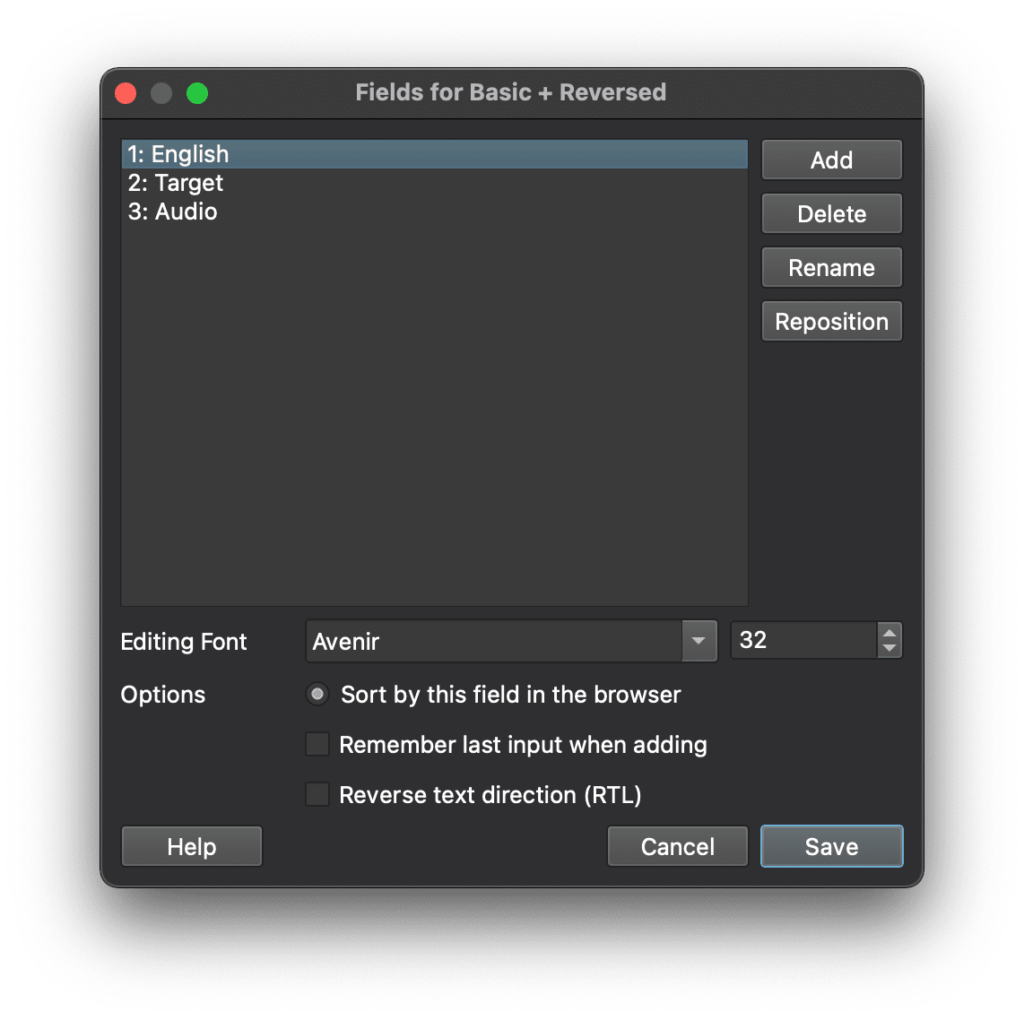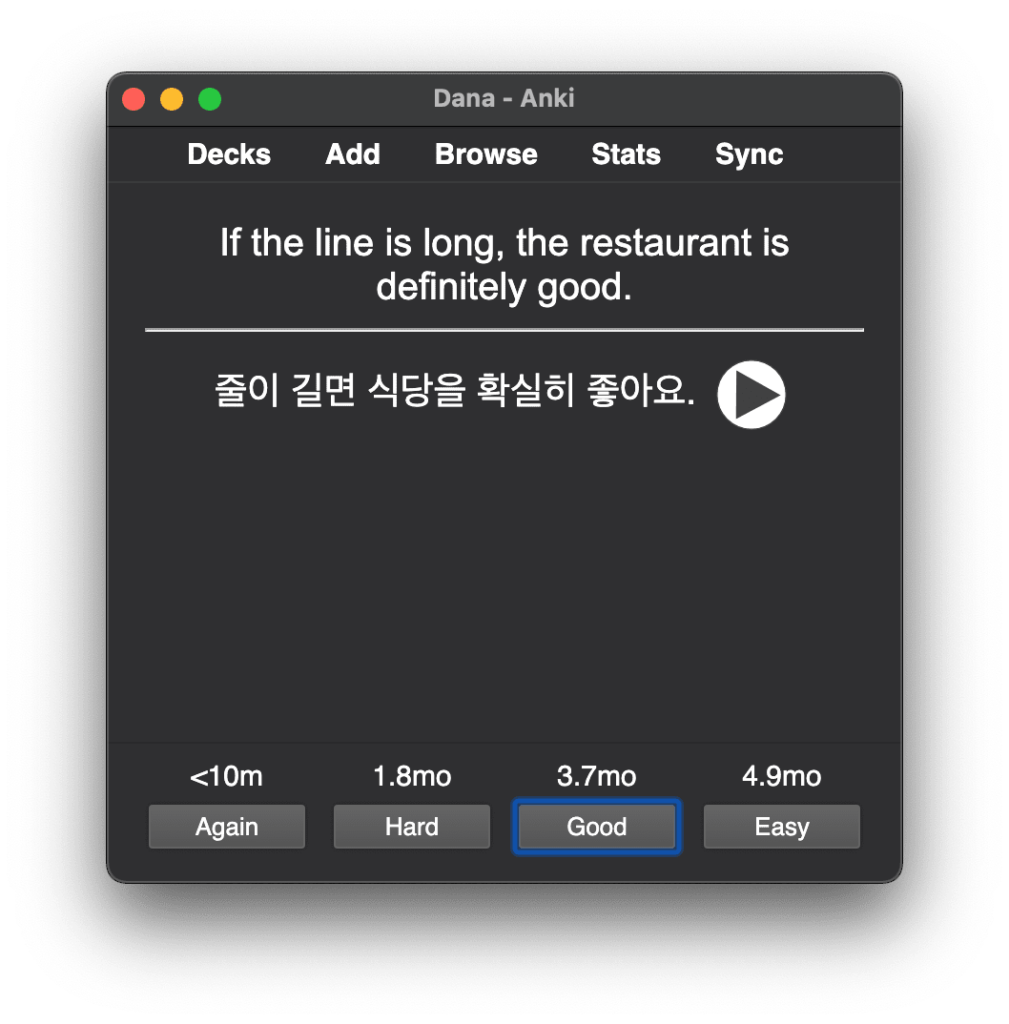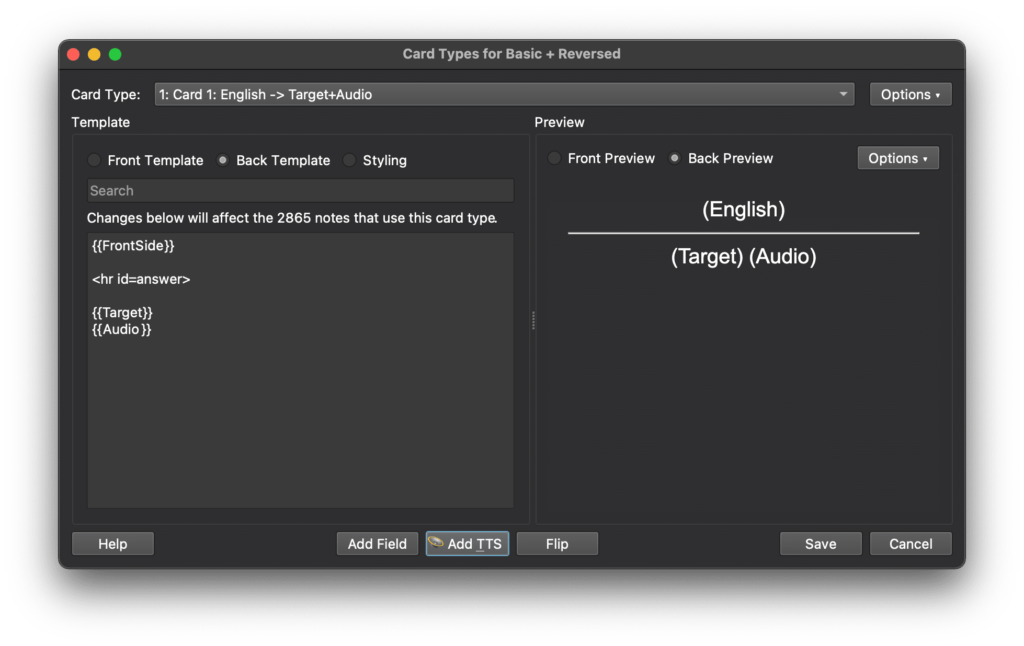The One Sentence a Day Language Learning Technique — Pros and Cons
This is my explanation of my latest method, the “one sentence a day” language-learning method. I’ve been using it for a while now, and put it to use, and wanted to go over the pros and cons.
Because I don’t like to keep people waiting, here it the “one sentence a day” language learning method in a nutshell:
Every day, learn a new sentence in your target language — something you would use, like “I can’t find my phone” or “I’m eating because I’m bored”.
Put it into your Anki flashcard deck, with audio (either computer-generated or a recording of yourself), and learn it.
Every day, revise old sentences, and add new sentences, either reinforcing stuff you need to learn better, or adding new content.
There it is. If you like, you can go and try it. But I already have, and now I’ll tell you why I think this method is awesome (not necessarily the “best” or “fastest” or whatever), and do it Socratic style.
Why sentences, and not words, or rules?
Sometimes you do have to learn a rule, like a conjugation pattern.
But I find it’s much better to learn a rule by inference. If you see three sentences like “I eat”, “I speak”, and “I sleep” in another language and notice that they begin or end in a similar way, you think “Hey… I think that’s how you conjugate those verbs.”
If you can’t figure it out by inference, then you can look up the rule after having learned the examples.
Learning a rule after knowing some examples really helps you understand. You already have context! If you can’t figure it out and have to look it up, then sometimes the answer is that you found an exception.
I also prefer learning sentences to words because other than very common nouns, words often need context to have useful meaning.
Even very common words like “apple” are better learned in sentences. In some languages, you modify words like “apple” in unexpected ways when using plurals or cases. So learning sentences like “I really like apples” or “This apple tastes weird” are far more useful. And beyond those and maybe three other examples, you rarely say anything more profound about apples.
Adjectives and verbs have parallels between languages, but it’s never a 1:1 correlation. For example, in English you can say that a test was easy or simple, but saying you like to lead a “simple” life has a different meaning to wanting to lead an “easy” life. Context rules!
Why just one sentence a day?
Of course, you can learn two to five sentences a day. Or add several and then learn those over the course of a few days (this is what I often do).
It really depends on how much time you have and what else you’re doing.
The reason I suggest just one sentence a day is because of the cumulative effect of learning slowly.
When I add one sentence a day (on average), I still have to review all the sentences of past days. And if I find a word hard to learn, then I write more examples using the same word. It can pile up.
The second reason I suggest one sentence a day is that it gives me a reasonable fun morning task that won’t overwhelm me. It leaves me with time for other things in my life.
Doing something at this rate means I can learn a couple of languages at once almost passively and also keep on doing other things in my life that I enjoy, including work and relationships. It takes me about 10 minutes a day.
You might ask: Isn’t one sentence a day a very slow way to learn a language?
Yes, learning a language by one sentence a day is slow. It will take me years to get anywhere.
But all language learning is slow. No matter how quickly you memorise a list of verbs, it takes years before you really know how to do use them well.
Kids take years to speak languages well. They can communicate pretty well by the time they’re five or so, and they may take longer if they’re learning more than one language at once.
I used to think learning languages was about doing it fast. Many language learners do.
But over time, I’ve realised that it is a really slow burn. Most things in life are. You can cram for a test, but you won’t remember anything later.
When I learned Arabic the first time in the year 2000, it took a while for difficult concepts to sink in like the fact that they do plurals, gender, and conjugation a bit differently.
But it simmered in my head for nearly two decades, with occasional reminders. Then, when I went to Egypt to learn Egyptian Arabic in 2019, I learned a lot more quickly.
I learned Italian really quickly before a trip to Italy. But it would have been impossible if I hadn’t been listening to Italian radio on the way to university every day in the car, trying to figure it out, and wondering what participles like “quindi” or “perciò” meant.
So I might be lucky to be able to have a basic Russian conversation in five years. That’s roughly the time frame I’m setting myself. But by then, I’ll be really confident in those basics, using about 1-2000 words with aplomb.
There’ll be plenty of gaps, but I’ll then be equipped to learn more intensely.
The advantage of learning languages slowly
Expanding on the previous point, there are a few reasons why learning a language slowly make sense.
Firstly, not everything is top priority. I’m often working on many things, including a number of languages and personal and professional projects. Then there’s family, friends, my other hobbies, etc. So this isn’t the approach I suggest for your primary projects.
Secondly, with some things it’s better to start with a little, over a long period of time, rather than diving in 100% when you have all the time in the world.
Starting early and going slowly with a language gives you time to
- Get familiar with the way a language sounds
- Get used to making the sounds with your mouth — pronouncing unusual sounds gets harder as we get older
- Becoming accustomed to language quirks like cases and genders
You can generally summarise the above as “becoming familiar”. It’s a bit like just hearing a language around the house fo many years, understanding some of it.
How to pick sentences to learn
One sentence a day? No problem! But what sentence?
There are a number of different sources of inspiration I use for sentences I want to learn.
I start with my everyday needs. If I’m talking to my partner about something like the weather, I pick those sentences. It usually starts with “It’s warm today”. Then I might add tomorrow, or yesterday, like “Yesterday it was warm, but today it’s cold.”
Another source of inspiration is imagining situations. Like a lesson with a language teacher. Often, early in my lessons with a teacher, I have to say things like “I didn’t hear you clearly. The line was bad” or “Can you please say that again?” So I learn those.
A third source of inspiration is the mistakes that I make or words I’m struggling to learn. If I struggle to learn a word, I make more sentences with that word, trying not to add too many new words.
Fourth, sometimes sentences from external sources like Speechling or Glossika. I rarely use those sentences verbatim, but adapt them to suit my life.
Fifth, it’s useful to learn what people are saying, so you can understand prompts in everyday life. So when you go to restaurants, bars, or supermarkets in whatever country you live in, think about what people say, like “do you need a receipt?” or “do you have a loyalty card?”. (These are low priority, but pretty easy!)
Finally, if I take language classes, then I add sentences that I said awkwardly and that my teacher corrected me on. These go straight into my Anki deck.
Sources for sentences to learn
My main source for target sentences for my “one sentence a day method” is Google Translate!
I wrote a separate piece on this on learning a language from Google Translate.
Learning from Google Translate does mean you have to know a few basics before you can use it.
If you’re learning a language that has levels of formality, then you should know how to move between those levels of formality. It’s not fatal if you don’t, but it’s helpful if you do.
But at least you can usually be reasonably confident in the accuracy of a translation and the pronunciation.
Google Translate is good for a lot of languages, but it’s not so good for dialects like Egyptian Arabic. For that, I tend to use instruction books or books like the Big Fat Book of Egyptian Arabic Verbs which has loads and loads of sample sentences in it.
Of course, if you use any language course, then you can take sentences from those and just bung them into your Anki flashcards.
How to use Anki to Learn One Sentence a Day
My basic card design is:
- Two-sided note
- English on one side (no audio)
- Target language and audio on the other side
The fact that it’s a two-sided note means that every note has two cards, one the inverse of the other.
I use Anki listening as much as I can, without reading the prompts when it’s in the target language.
I don’t like to use English language audio because I find listening to English dilutes the immersive learning experience.
How to Add Native Audio
For a language to really stick learning one sentence a day, you should both say the sentences and get used to listening to the audio.
The easiest way to do this is to listen to the Google Translate pronunciation a few times and then mimic that, recording your own voice.
I have found that in early days, I made mistakes with audio. But I kind of figured it out later, even just a few months later, and when those cards came up, I re-recorded the voice.
Another way of adding audio is with a plugin called AwesomeTTS. You can either become a paying member (it’s not expensive), or you can go through the rigmarole of getting an Azure license, which gets you a huge number of pronunciations in your free tier (I did this because I’m a huge nerd).
Here are some sample audio clips from AwesomeTTS:
- Spanish: ¿Podemos sentarnos adentro? Hace demasiado calor afuera.
- German: Es ist zu teuer, aber es ist wirklich köstlich.
- Chinese: 我真的不知道点什么。 请推荐一下一个好吃的菜!
- Korean: 제가 중국에 가기 전에 중국에 대해 많이 알지 못했어요.
- Russian: Ты готова?
(My Russian is very A1 level…)
I think 99% of people won’t bother with the Azure license, which is fine as I’m all about paying developers who make awesome things, and I encourage you to!
The automatic text-to-speech engine sounds very natural. But it does struggle with some human things like question or exclamation intonation. Everything sounds like a statement.
The only language I’ve studied that doesn’t work well with Azure is Egyptian Arabic, as it’s a dialect. Azure tends to pronounce it as in Modern Standard Arabic, which is quite different. If you’re learning MSA, it might still be a good option.
Examples of Languages studied — Korean, German, and Russian
Since mid 2020 I have been learning Korean in this method (over two years), varying in intensity levels around work and so on. I averaged maybe 3-5 sentences a day — many of them going over former words and not intensely building vocabulary.
As kind of a “break”, I’ve also been learning German. And for fun, slowly learning Russian.
It has been such tremendous help with my Korean. When I take Korean classes, after around 1.5 years of this method, I take my classes entirely in Korean and discuss everyday things. It’s hard and I do forget things and sometimes my phrasing is awkward, but I have enough vocabulary for everyday life because that’s exactly what I’ve been learning.
Teachers are generally surprised at my level — which I think is because I can say the important things to well. I’d be quickly out of my depth if it turned to a topic I don’t know.
When I casually use German with people (usually Uber drivers) on trips to Germany, they’re shocked that I haven’t ever formally studied German. Again, I might get cases and genders wrong sometimes, but I’m not so worried about it.
I’ve barely started Russian. But my goal isn’t to get anywhere fast; just to be familiar with it in a number of years when I have time to study it more intensely, rather than starting from zero then.
Pre-made Sentence banks (Glossika / Speechling)
You can definitely use a pre-made sentence bank like Glossika or Speechling. We’re big fans of those, and they’re an easy way to dose in a language.
You can also use those as inputs. They have lots of good examples. Speechling is searchable, which means that when you need a usage example, you can look through their database of sentences in languages they cover (not as many as Glossika).
The advantages of building your own deck of sentences are that:
- You’re studying more actively. You’re forced to look up phrases and words, and that helps you learn.
- Everything will be more applicable to your everyday life. While the sentences in Glossika and Speechling are normal ones, they aren’t exactly what you’d want to say
- You get to pace yourself better, not go at some software’s artificial pace.
- It’s free (or much cheaper) to do it this way.
The advantages of sentence packs like Glossika or Speechling are, of course, that you are guaranteed a good database of sentences and languages, and the pronunciation is going to be correct as it’s by a human.
They’re worth a try (they have free trials), but they’re not the only way.
Try Glossika for a Week for Free
Try Glossika’s method of teaching language through thousands of sample sentences. Learn languages by sentences spoken by native speakers in over 60 languages.
Try Speechling – It’s Free (for one language)
Sign up to Speechling with the link below. Get access to all sentences for one language, review from a real tutor, and their apps — for free. The paid version lets you get unlimited access and offline mode.
Downsides of the One Sentence a Day method
Now that I’ve been putting the “one sentence a day” method to use for some time, I wanted to mention some of the downsides.
There are three main downsides:
- I don’t learn phrasing that doesn’t exist in my mother tongue
- I’m weak at listening
- I haven’t drilled the basics enough
I’ll go over these in detail in another article, but gloss over them here.
Firstly, in any language, there are many ways of saying things that don’t exist in your mother tongue.
For example — greetings. They’re vastly different in any language. If you say ask someone how to say “hello” in Korean, they’ll tell you it’s annyeonghaseyo, but what they can’t teach you concisely is all the different ways of greeting in that language.
For example, in Korean you can great someone with:
- 안녕하세요! (annyeonghaseyo!)
- 안녕! (annyeong!)
- 안녕하십니까! (annyeonghashibnikka!)
And the one you choose depends entirely on the level of formality. On the other hand, if you ask someone how to say “Good morning” or “Good evening”, you’ll get an answer, but it won’t be a phrase you’ll ever use.
The second weakness is that I have to do a lot more listening than speaking in reality. By focusing on things to say, I haven’t focused enough on what people say.
Finally, everyday life is a repetition of many basic situations of greetings and basic interactions. I was learning a lot of fancy expression, but not drilling the basics enough.
Still, I quite enjoy my one sentence a day method. I continue to use it, but now I’m padding it out with practising everyday interactions and also expanding my listening practise.
Summary — Is the “one sentence a day” language learning method for you?
I’m sharing the above because it works for me and I’ve tried a lot of things in language learning. It’s fun, it’s easy, and it’s free (or nearly free, if you pay for AwesomeTTS or Anki on your iPhone).
It’s not the only or the “best” language-learning method. Nor is it the one I’ll use forever. It has its weaknesses, as I mention.
But it certainly works for me for now and I think more people should incorporate it into their study programs.









